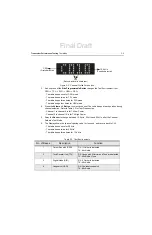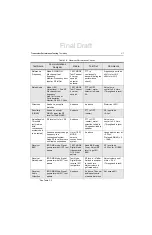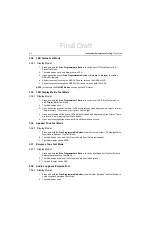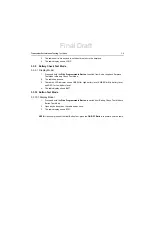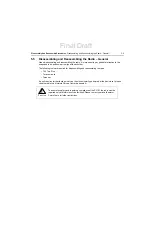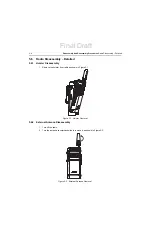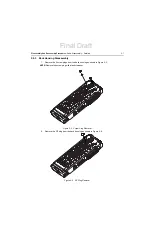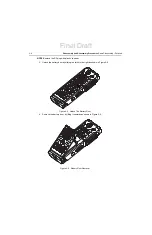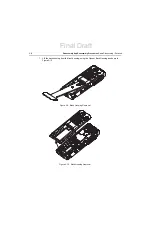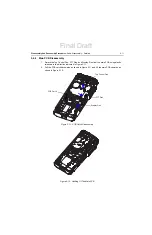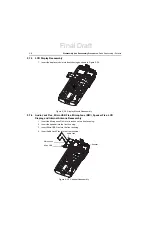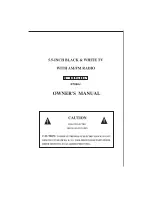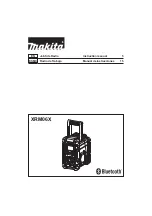
Disassembly And Reassembly Procedures
: Safe Handling of CMOS and LDMOS Devices
5-3
5.3
Safe Handling of CMOS and LDMOS Devices
Complementary metal-oxide semiconductor (CMOS) and Laterally Diffused Metal Oxide
Semiconductor (LDMOS) devices are used in this family of radios, and are susceptible to damage by
electrostatic or high voltage charges. Damage can be latent, resulting in failures occurring weeks or
months later. Therefore, special precautions must be taken to prevent device damage during
disassembly, troubleshooting, and repair.
Handling precautions are mandatory for CMOS/LDMOS circuits and are especially important in low
humidity conditions. DO NOT attempt to disassemble the radio without first referring to the CMOS
CAUTION paragraph in the Disassembly and Re-assembly section of the manual.
DO NOT attempt to disassemble the radio without first referring to the following CAUTION
statement.
This radio contains static-sensitive devices. Do not open the radio unless you are
properly grounded. Take the following precautions when working on this unit:
• Store and transport all CMOS/LDMOS devices in conductive mate-
rial so that all exposed leads are shorted together. Do not insert
CMOS/LDMOS devices into conventional plastic “snow” trays used
for storage and transportation of other semiconductor devices.
• Ground the working surface of the service bench to protect the
CMOS/LDMOS device. We recommend using the Motorola Static
Protection Assembly (part number 0180386A82), which includes a
wrist strap, two ground cords, a table mat, and a floor mat.
• Wear a conductive wrist strap in series with a 100k resistor to
ground. (Replacement wrist straps that connect to the bench top
covering are Motorola part number 4280385A59).
• Do not wear nylon clothing while handling CMOS/LDMOS devices.
• Do not insert or remove CMOS/LDMOS devices with power applied.
Check all power supplies used for testing CMOS/LDMOS devices to
be certain that there are no voltage transients present.
• When straightening CMOS/LDMOS pins, provide ground straps for
the apparatus used.
• When soldering, use a grounded soldering iron.
• If at all possible, handle CMOS/LDMOS devices by the package and
not by the leads. Prior to touching the unit, touch an electrical
ground to remove any static charge that you may have accumu-
lated. The package and substrate may be electrically common. If so,
the reaction of a discharge to the case would cause the same dam-
age as touching the leads.
!
C a u t i o n
Final Draft
Summary of Contents for SL1M
Page 1: ...tTitle Page SL1M Portable Radio Basic Service Manual MN000916A01 AA tttt Final Draft ...
Page 2: ...Final Draft ...
Page 4: ...Notes Final Draft ...
Page 6: ...vi Notes Final Draft ...
Page 10: ...x Table of Contents Notes Final Draft ...
Page 12: ...xii List of Figures Notes Final Draft ...
Page 14: ...xiv List of Tables Notes Final Draft ...
Page 16: ...xvi List of Tables Notes Final Draft ...
Page 36: ...Notes 2 6 Test Equipment and Service Aids Audio Test Cable Final Draft ...
Page 46: ...Notes 3 10 Transceiver Performance Testing Test Mode Final Draft ...
Page 50: ...Notes 4 4 Radio Programming and Tuning Radio Tuning Setup Final Draft ...
Page 78: ...Notes 5 28 Disassembly And Reassembly Procedures Torque Chart Final Draft ...
Page 82: ...Notes 6 4 Basic Troubleshooting Operational Error Codes Final Draft ...
Page 89: ...Final Draft ...

